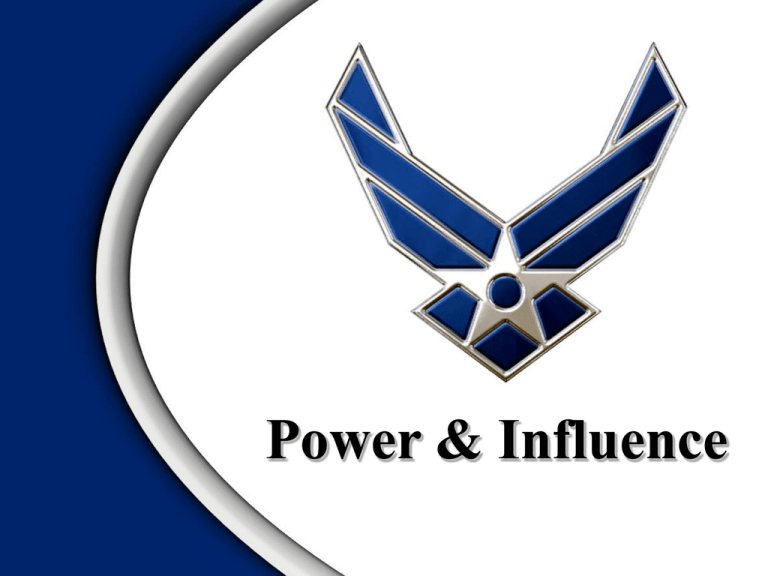Transforming Power into Influence
advertisement

Power & Influence Overview • • • • Power vs. Influence Sources of Power Transforming Power into Influence Case Study Power vs. Influence • Power - capacity to produce effects on others • Influence -the change in attitudes, values, beliefs, or behavior as a result of power Expert Power • Is the power of knowledge • Followers can have more expert power than leaders in certain situations Example: Leader new to unit 4 Referent Power • Refers to the influence one has due to the strength of the relationship between the leader and the followers • Often takes time to develop Example: Followers admire and respect the leader 5 Legitimate Power • One’s formal or official authority Example: Authority you have due to your rank 6 Reward Power • The potential to influence others due to one’s control over desired resources Examples: OPRs, EPRs, PRFs, awards and decorations, Officer/Enlisted/Civilian of the Quarter Award 7 Coercive Power • The potential to influence others through the administration of negative sanctions Examples: LORs, LOCs, Article 15s, Courtsmartial 8 Transforming Power into Influence • Three R’s – Retribution – Reciprocity – Reason • Persuasive • Manipulative • Upward Influence Transforming Power into Influence • Three R’s – Retribution: threatening • Direct - explicit threat of punishment (coercion) • Indirect - threat is implied rather than stated (intimidation) Pros Cons • Produce immediate effect • Creates resistance, resentment, & alienation • Follows manager specification • Stifles initiative & innovation Effective managers use this sparingly; reserve for crisis Transforming Power into Influence • Three R’s – Reciprocity: compliance by satisfying the needs of both parties (favors thru social obligations) Pros Cons • Results w/o resentment • Requires trust • Both parties benefit • Expect negotiations for requests • Don’t have to justify actions (bargain) • Undercuts group commitment Transforming Power into Influence • Three R’s – Reason: articulation of the concept; subordinates recognize the value of the plan • • • • • Pros Higher compliance Commitment to group principles Superiors rate highly effective Low levels of stress High job satisfaction Cons • Takes time to build trust • More people involved, longer it takes Transforming Power into Influence • Three R’s – Reason: articulation of the concept; subordinates recognize the value of the plan Persuasion Explicit, direct, and respects the judgment/ability of the subordinate Manipulation based on disrespect subordinates’ abilities and a lack of trust in their judgment Transforming Power into Influence • Upward Influence – Influence on superior – Shield subordinates from distractions – Strengthens manager’s power base – Issue Selling: convince boss issue requires attention – Trickle-Up Influence Transforming Power into Influence • Upward Influence – Trickle-Up Influence • Necessary because of decentralization of today’s workplace • Superiors need to be informed • Speak up - talk about good ideas to superiors • Team up - gather allies for credibility • Lead up - display open-mindedness, support, trust • Be straightforward Interim Summary • • • • • • • Establish power thru personal attributes (pp. 177-181) Transform power into influence using Three R’s Use power to engender trust Emphasize reciprocity & reason Use retribution in crisis Influence flows up & down chain Upward influence should be for good of group, not personal ambition Case Study Summary • • • • Power vs. Influence Sources of Power Transforming Power into Influence Case Study A Good Thought “ Whoever knows how to restrain and effectively release power finds . . . that power flows back to him.” A. Bartlett Giamatti 19 A Better Thought “ Leaders who share their power and their time can accomplish extraordinary things. The best leaders understand that leadership is the liberation of talent; hence they gain power not only by constantly giving it away, but also by not grabbing it back.” MG Perry Smith, “Learning to Lead” Marine Corps Gazette, Jan 1997 20








